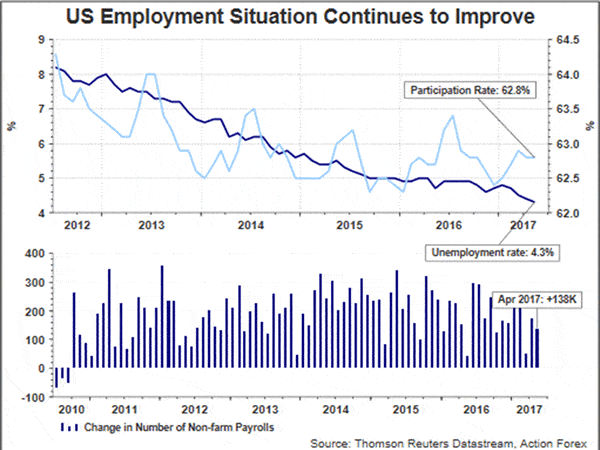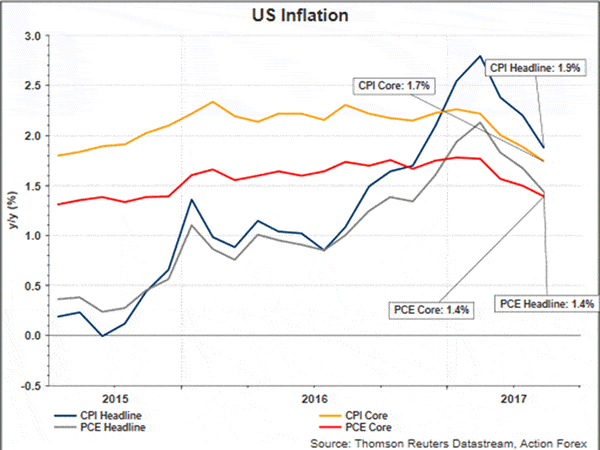The FOMC minutes for the June meeting unveiled that members were divided over the timing of balance sheet reduction while there was also discussion over the recent inflation weakness. At the meeting, the Fed raised its policy rate, by +25 bps, to a target range of 1-1.25%.Given the fact that the economic and medium-term inflation outlooks was largely unchanged since May, members generally judged that it was appropriate to adopt the continued removal of monetary policy accommodation. The rate hike decision was not unanimous. Minneapolis Fed president Neel Kashkari dissented as he preferred to keep the policy rate unchanged until inflation was "actually moving toward the 2% longer-run objective". Meanwhile, "a few" members who voted in favor of a rate hike in June indicated that "they were less comfortable with the degree of additional policy tightening through the end of 2018 implied by the June SEP median federal funds rate projections" (i.e. three rate hike as suggested at the June SEP). These participants noted that "such a path of increases in the policy rate, while gradual, might prove inconsistent with a sustained return of inflation to +2%".
The minutes reflected the division among members regarding the timing of balance sheet reduction as well as how it would affect the path of interest rate hike. While "several preferred to announce a start to the process within a couple of months", "some others emphasized that deferring the decision until later in the year would permit additional time to assess the outlook for economic activity and inflation". Concerning the interaction with the monetary policy, the minutes revealed that "several participants indicated that the reduction in policy accommodation arising from the commencement of balance sheet normalization was one basis for believing that, if economic conditions evolved broadly as anticipated, the target range for the federal funds rate would follow a less steep path than it otherwise would". Yet, "some other participants suggested that they did not see the balance sheet normalization program as a factor likely to figure heavily in decisions about the target range for the federal funds rate". Some members holding the latter view "judged that the degree of additional policy firming that would result from the balance sheet normalization program was modest".
The members also debated over the appropriate response to the tightening employment market. The minutes revealed that "several participants endorsed a policy approach" where the employment market would fall below the estimated NAIRU for a sustained period, while some others "expressed concern that a substantial and sustained unemployment undershooting might make the economy more likely to experience financial instability or could lead to a sharp rise in inflation".
Recently, both headline and core readings of inflation came in lower-than-expected. Regarding this, most members viewed the weakness as "largely reflecting idiosyncratic factors, including sharp declines in prices of wireless telephone services and prescription drugs. They expected these developments as transitory and having "little bearing on inflation over the medium run". The members retained the view that, as "the effects of transitory factors waned and labor market conditions strengthened further, inflation would stabilize around the Committee's +2% objective over the medium term". Yet, "several" members raised concerns that progress toward the Committee's +2% longer-run inflation objective might have "slowed and that the recent softness in inflation might persist". They believed that limited upward pressure on inflation from resource utilization might have been a reason causing the softness. There were also "a couple" of members raising the concern that "a tighter relationship between inflation and resource utilization could reemerge if the unemployment rate ran significantly below its longer-run normal level, which could result in inflation running persistently above the Committee's +2% objective".
The minutes unveiled that the Fed still lacked consensus over the balance sheet reduction schedule. Therefore, it would be very unlikely to begin in September though some members suggested it could begin in as soon as a few months. Should the economic activities and the job market maintain the current pace of improvement, we maintain the view that the Fed would announce a more detailed plan (schedule and mechanism, etc.) on balance sheet reduction in September while a +25 bps rate hike would be adopted in December.
Content in ActionForex.com website is for informational purposes only. Contributors submitted forecast, commentaries, analysis, articles are based upon information gathered from various sources believed to be reliable, complete, and accurate. However, no guarantee can be made as to the validity of the believed sources. All statements and expressions in the website are opinions, and not meant as investment advice or solicitation. Forex Markets can be volatile and opinions may change without notice.
Recommended Content
Editors’ Picks
AUD/USD pressures as Fed officials hold firm on rate policy

The Australian Dollar is on the defensive against the US Dollar, as Friday’s Asian session commences. On Thursday, the antipodean clocked losses of 0.21% against its counterpart, driven by Fed officials emphasizing they’re in no rush to ease policy. The AUD/USD trades around 0.6419.
EUR/USD extends its downside below 1.0650 on hawkish Fed remarks

The EUR/USD extends its downside around 1.0640 after retreating from weekly peaks of 1.0690 on Friday during the early Asian session. The hawkish comments from Federal Reserve officials provide some support to the US Dollar.
Gold price edges higher on risk-off mood hawkish Fed signals

Gold prices advanced late in the North American session on Thursday, underpinned by heightened geopolitical risks involving Iran and Israel. Federal Reserve officials delivered hawkish messages, triggering a jump in US Treasury yields, which boosted the Greenback.
Runes likely to have massive support after BRC-20 and Ordinals frenzy

With all eyes peeled on the halving, Bitcoin is the center of attention in the market. The pioneer cryptocurrency has had three narratives this year already, starting with the spot BTC exchange-traded funds, the recent all-time high of $73,777, and now the halving.
Billowing clouds of apprehension

Thursday marked the fifth consecutive session of decline for US stocks as optimism regarding multiple interest rate cuts by the Federal Reserve waned. The downturn in sentiment can be attributed to robust economic data releases, prompting traders to adjust their expectations for multiple rate cuts this year.

